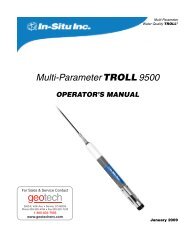TEST INSTRUCTIONS - Geotech Environmental Equipment
TEST INSTRUCTIONS - Geotech Environmental Equipment
TEST INSTRUCTIONS - Geotech Environmental Equipment
Create successful ePaper yourself
Turn your PDF publications into a flip-book with our unique Google optimized e-Paper software.
PROCEDURE<br />
1. Press and hold ON button until colorimeter turns on.<br />
2. Press ENTER to start.<br />
3. Press ENTER to select <strong>TEST</strong>ING MENU.<br />
4. Select ALL <strong>TEST</strong>S (or another sequence containing 81 Potassium)<br />
from <strong>TEST</strong>ING MENU.<br />
5. Scroll to and select 81 Potassium from menu.<br />
6. Rinse a clean tube (0290) with sample water. Fill to the 10 mL line with<br />
sample.<br />
7. Insert tube into chamber, close lid and select SCAN BLANK.<br />
8. Remove tube from colorimeter. Add 4 drops of *Sodium Hydroxide, 1.0N<br />
(4004WT). Cap and mix.<br />
9. Use the 0.05 g spoon (0696) to add one measure of *Tetraphenylboron<br />
Powder (6364). Cap and shake vigorously until all of the powder has<br />
dissolved. Wait 5 minutes.<br />
10. At end of 5 minute waiting period, mix tube again to suspend any settled<br />
precipitate. Insert tube into chamber, close lid and select SCAN SAMPLE.<br />
Record result.<br />
11. Press OFF button to turn colorimeter off or press EXIT button to exit to a<br />
previous menu or make another menu selection.<br />
NOTES: For best possible results, a reagent blank should be determined to<br />
account for any contribution to the test result by the reagent system. To<br />
determine the reagent blank, follow the above test procedure to scan a distilled<br />
or deionized water blank. Then follow the above procedure to perform the test<br />
on a distilled or deionized water sample. This test result is the reagent blank.<br />
Subtract the reagent blank from all subsequent test results of unknown samples.<br />
It is necessary to determine the reagent blank only when a new lot number of<br />
reagents are obtained.<br />
For the most accurate results, the sample and reagents should be at 25±4°C.<br />
Potassium 2/2 Smart2 <strong>TEST</strong> PROCEDURES 2.04

















